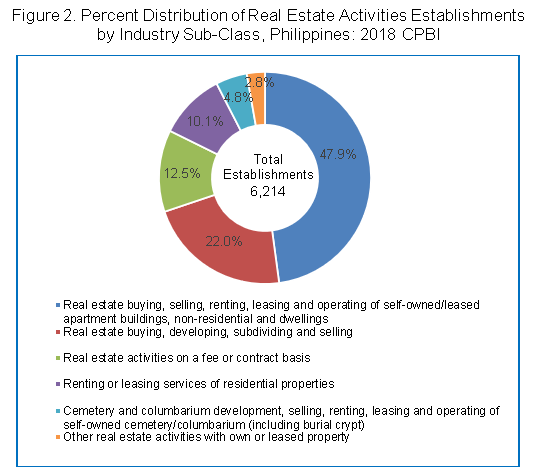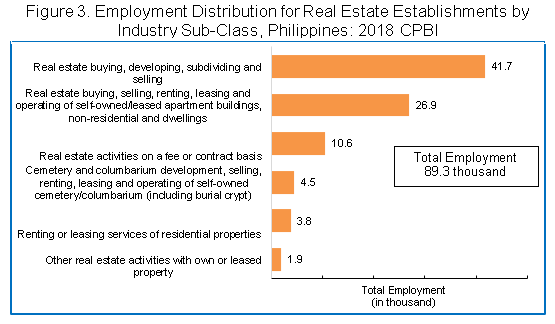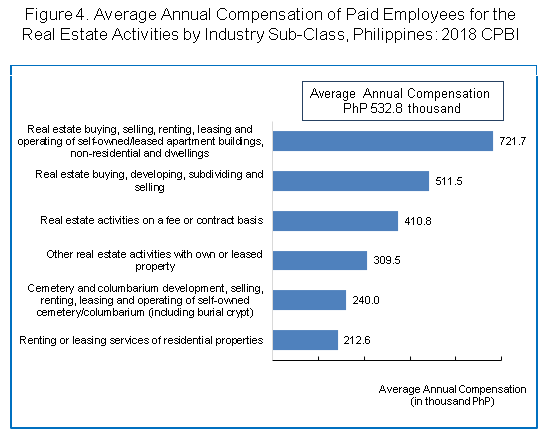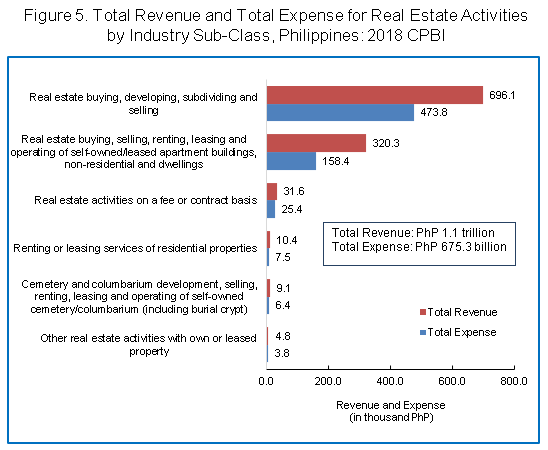The industry section on real estate activities (Section L) includes six industry sub-classes covering activities of units acting as lessors, agents, and/or brokers in one or more of the following: selling or buying real estate, renting real estate, providing other estate services such as appraising real estate, or acting as real estate escrow agents. This also includes the building of structures, combined with maintaining ownership or leasing of such structure.
Figure 1 presents the selected statistics on the number of establishments, total employment, total revenue, total expense, and total value added. It also includes ratios on employment per establishment, revenue per expense, and value added per employee. Growth rates on these selected statistics and indicators from the results of the 2012 CPBI are also presented.

Real estate buying, selling, renting, leasing, and operating of self-owned/leased apartment buildings, non-residential and dwellings comprised almost half of the total number of real estate activities establishments
In 2018, there were 6,214 establishments in the formal sector of the economy engaged in real estate activities, a 33.5 percent increase from the 4,656 establishments recorded in 2012. (Table A)
The real estate buying, selling, renting, leasing and operating of self-owned/leased apartment buildings, non-residential and dwellings with 2,975 establishments comprised 47.9 percent of the total number of establishments in the industry section. (Table 1A and Figure 2)
Real estate buying, developing, subdividing, and selling with 1,365 establishments (22.0%) recorded the next highest number of establishments. (Table 1A and Figure 2)

The National Capital Region (NCR) led in terms of number of real estate activities establishments
NCR led other regions in terms of number of establishments. Of the 6,214 establishments engaged in the industry, 2,615 (42.1%) establishments were located in the region.
CALABAZON and Central Visayas followed with 476 establishments (7.7%) and 435 establishments (7.0%), respectively. (Table 3A)
Real estate buying, developing, subdividing, and selling employed the greatest number of workers
The real estate activities industry engaged a total of 89,337 personnel in 2018. This translates to a 17.1 percent increase from the total employment of 76,282 recorded in 2012. (Table A)
The average employment per establishment was recorded at 15 persons.
The real estate buying, developing, subdividing, and selling industry sub-class employed 41,686 persons and shared the biggest portion to the total at 46.7 percent. This industry sub-class also recorded the highest average employment per establishment with 31 persons. (Table 1A and 2)
Real estate buying, selling, renting, leasing, and operating of self-owned/leased apartment buildings, non-residential and dwellings followed with 26,890 employees or 30.1 percent share. (Table 1A and Figure 3)

NCR employed more than half of the real estate industry’s employment
NCR, with 53,335 (59.7%) employees, contributed the highest percent share to total. This was followed by Central Visayas with 6,981 (7.8%) and CALABARZON with 6,920 (7.7%). (Table 3A)
In addition to the 89,337 employees in real estate activities, the industry also engaged the services of 17,161 workers on sub-contract agreement or under manpower agencies. (Table 1)
The top three regions which engaged sub-contracted workers were NCR with 9,760 (56.9%), Central Visayas with 2,196 (12.8%) and CALABARZON with 1,471 (8.6%). (Table 3)
Across industry groups, majority of the sub-contracted workers were engaged in real estate buying, selling, renting, leasing and operating of self-owned/leased apartment buildings, non-residential and dwellings activities with 6,638 (38.7%) workers and in real estate buying, developing, subdividing, and selling with 6,373 (37.1%) workers. (Table 1)
A real estate employee received an average annual compensation of PhP 532,826
The 6,214 real estate establishments spent a total of PhP 47.0 billion for the compensation of employees. This translates to an average annual compensation of PhP 532,826 per paid employee.
Among the six industry sub-classes, the real estate buying, selling, renting, leasing, and operating of self-owned/leased apartment buildings, non-residential and dwellings paid the highest annual compensation of
PhP 721,678. This is the only industry with a ratio higher than that of the national level.
Real estate buying, developing, subdividing, and selling paid the second highest annual compensation of PhP 511,502. (Table 1 and Figure 4)

Real estate buying, developing, subdividing, and selling contributed the biggest share to total revenue
The real estate industry generated a total revenue of PhP 1.072 trillion, an increase of 33.5 percent from the PhP 0.803 trillion reported in 2012. (Table A)
Real estate buying, developing, subdividing, and selling contributed the biggest share to total revenue with PhP 696.1 billion or 64.9 percent of the total. The same industry also incurred the highest share to total expense of PhP 473.8 billion or 70.2 percent of the total. (Table 1A and Figure 5)
Real estate buying, selling, renting, leasing and operating of self-owned/leased apartment buildings, non-residential and dwellings generated the second highest revenue with PhP 320.3 billion or 29.9 percent share. It similarly incurred the next highest expense of PhP 158.4 billion or 23.5 percent share. (Table 1A and Figure 5)

NCR dominated the real estate industry in terms of revenue generated
Of the PhP 1.072 trillion total revenue generated by the real estate activities industry, NCR generated PhP 928.7 billion (86.6%), the highest among other regions. Similarly, NCR incurred the highest expense with PhP 579.2 or 85.8 percent of the total.
Central Visayas contributed PhP 39.5 billion (3.7%) to the total revenue and PhP 26.5 billion (3.9%) to the total expense.
Central Luzon posted the third highest revenue generated of PhP 31.0 billion or 2.9 percent of the total. (Table 3A)
Revenue per expense ratio of most regions exceeded the national level
The PhP 1.1 trillion total revenue generated and the PhP 675.3 billion total expense incurred translated to a revenue-expense ratio of 1.6. This indicates that, on the average, establishments engaged in this industry earned about 60 centavos for every one-peso expense.
Five (5) of the 17 regions had higher revenue-expense ratios than the national level. These were Cagayan Valley (2.1), Bicol Region (2.0), Ilocos Region (2.0), Central Luzon (1.9), and NCR (1.6). (Table 4)
Among industry sub-classes, real estate buying, selling, renting, leasing, and operating of self-owned/leased apartment buildings, non-residential and dwellings with revenue-expense ratio of 2.0 had a higher ratio than the national level. (Table 2)
Real estate buying, developing, subdividing, and selling contributed about half of the total value added generated by the industry
The total value added generated by the industry amounted to PhP 543.9 billion. This shows an increase of 142.0 percent from the PhP 224.8 billion recorded in 2012. (Table A)
Real estate buying, developing, subdividing, and selling industry sub-class contributed the highest value added with PhP 269.0 billion or 49.5 percent of the total. (Table 1A and Figure 6)
This was followed by real estate buying, selling, renting, leasing and operating of self-owned/leased apartment buildings, non-residential, and dwellings which generated PhP 255.2 billion or 46.9 percent of the total value added. (Table 1A and Figure 6)
Across regions, NCR accounted for PhP 480.3 billion or 88.3 percent of the total value added. (Table 3A)
DENNIS S. MAPA, Ph.D.
Undersecretary
National Statistician and Civil Registrar General
